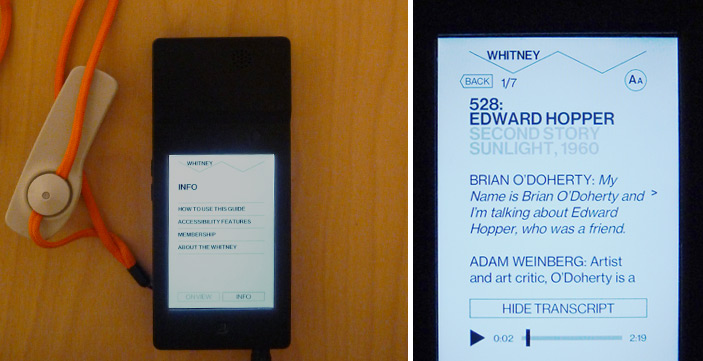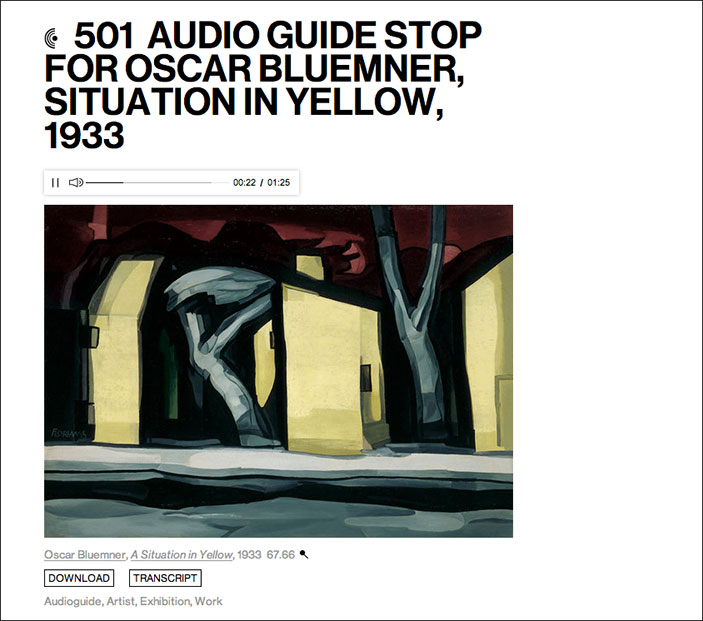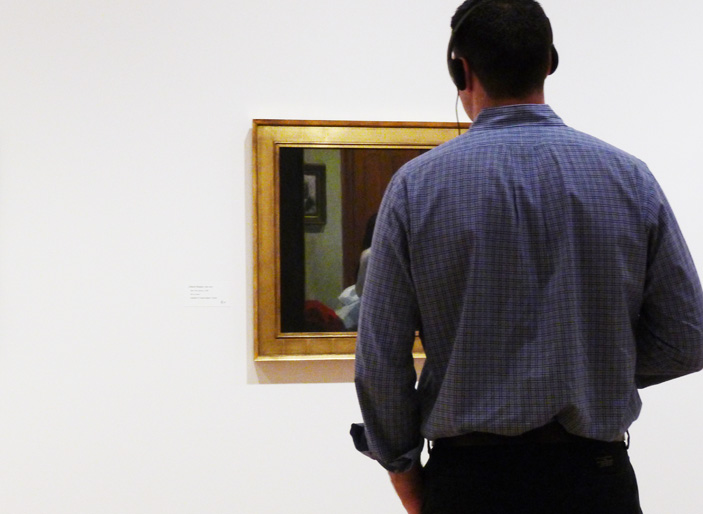I spent my summer as an intern in the Digital and Emerging Media department here at the Cooper-Hewitt National Design Museum. Next week, I head home to San Francisco where I will return to the graduate program in design at California College of the Arts. One of my projects this summer has been to visit museums, observe how visitors are using their devices (cell phones, iPads, etc), and to examine audio guides through the lens of an interaction designer.
When I went to check out MoMA’s new mobile guide, Audio+, it was the beginning of my stint at the Cooper-Hewitt, I had never before done a museum audio tour with an iPod touch, and my expectations were lofty. Now that I have spent a summer in Museum World, my perspective and my expectations have changed so I wanted to repeat the exercise of going to a museum and critiquing an audio guide experience.
Last Sunday I spent my afternoon at the Whitney. I arrived at the museum around 1pm. No wait for the audio guide, just walked up and handed over my ID in exchange. Like many other museums, the Whitney uses encased iPods for their audio guides. I was a bit surprised, however, to notice that the battery charge on my guide was around 40%. This turned out not to be a problem for me, but I did overhear other guests complaining that their guides had run out of batteries part way through the visit.
The Whitney’s audio guide interface is simple and straight forward. All of the guide’s navigation is text based, and this digital affordance reinforced the fact that the guide does not offer endless paths and options. After just one or two minutes of clicking around the app, there was no more mystery. The minimalist design helped me to immediately understand what I was going to do with the device and it was easier for me to focus attention on what was on the walls rather than what was on the screen.
I was, and still am, pretty taken with the quality of content available on the Whitney’s guide. From what I could tell, in each room of each gallery there is audio content for at least two pieces. It may not sound like a lot, but it ended up being more than enough for me. The consistency of content allowed and encouraged me to use the guide throughout my visit and I was surprised to see how many visitors were using the audio guides – and not just tourists, but locals too.
According to Audio Guide stop 501, Oscar Bluemner once wrote, “Listen to my work as you listen to music…try to feel.” The Whitney’s audio guide embraces this idea by playing mood setting sounds and music to complement their audio descriptions.
One of my favorites is the description of Burchfield’s Chicket and Chorus in the Arbor, which you can listen to here. With crickets chirping in the background, it’s much easier to put yourself into the world described (late summer, thick trees and bushes, crickets, sunset). The first time I came across one of the audio guide stops with background music I was surprised and delighted. It was a subtle gesture, but one that really elevated the content and did wonders for putting me in the mood, so to speak.
In both the guide for the Whitney and the guide for the MoMA the museum’s own style is reflected. The MoMA states that their “mission is helping you understand and enjoy the art of our time” where as the Whitney is “dedicated to collecting, preserving, interpreting, and exhibiting American art.” It makes sense, then, that the MoMA (focussed on education) includes much more educational content in their mobile guide and that the Whitney does.
From what I’ve learned this summer (through working with the labs team and through visits to other museums), I know that the visitor experience at home is just as important as the visitor experience in the museum. For myself, I liked the Whitney guide so much because I didn’t feel compelled to do an incredibly deep dive on a mobile device when I should be focussing my attention on what is in front of me. However, where was my at home experience? Once I left the museum, I had nothing to take with me that would prompt me to visit their website and learn more about what I saw. I would love to follow up the great audio guide experience with a great at home experience in the vein of what MoMA is doing with the option to take your visit home. There is opportunity here and I hope the Whitney has plans to fill it.




Great post. Really important to get this perspective.